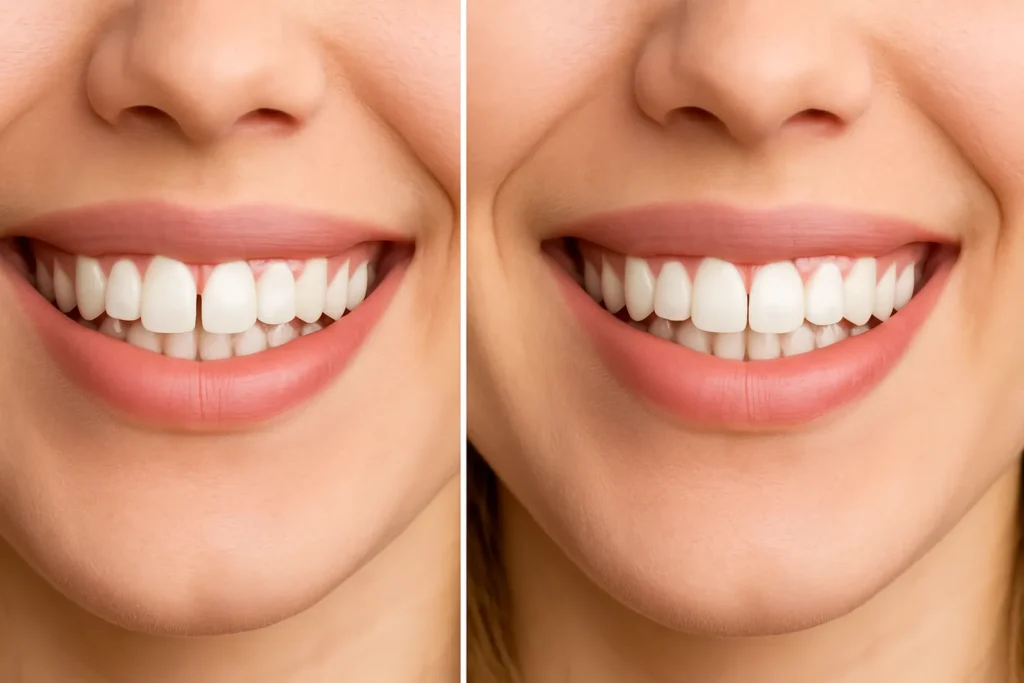Have you ever noticed a space between your teeth that makes you feel a little self-conscious when you smile? You’re not alone. Gaps between teeth, medically called diastema, are more common than most people think. And here’s the good news—there are ways to manage or reduce them naturally, right from the comfort of your home. Let’s take a friendly deep dive into how to reduce gap between teeth naturally at home, what causes it, and what really works without having to immediately jump to braces or cosmetic dental procedures.
What Causes Gaps Between Teeth?
Before we talk about how to fix the problem, it’s important to understand where it comes from. Gaps can appear between your front teeth, back teeth, or anywhere in the mouth. The most common causes include:
- Jaw Size and Tooth Size Mismatch: Sometimes, your jaw may be too large for the size of your teeth, which creates spaces in between.
- Thumb Sucking in Childhood: This habit pushes the teeth forward and creates gaps.
- Tongue Thrusting: A condition where your tongue presses against your front teeth while swallowing.
- Gum Diseases: Infections can weaken the gums and cause shifting of teeth.
- Missing Teeth: If a tooth is missing, nearby teeth can shift, causing a gap.
Understanding the cause helps you pick the right natural solution for your case.
How to Reduce Gap Between Teeth? Home Remedies

1. Dental Bands: A Popular Home Method
One of the most talked-about natural methods is the use of dental gap bands. These are small orthodontic rubber bands specifically designed to be worn around teeth with gaps. The pressure they apply can help bring teeth closer together over time.
How to Use:
- Place the band around the two teeth with a gap.
- Wear them for several hours a day or overnight (only if recommended).
- Make sure to maintain proper oral hygiene to avoid gum problems.
Note: Dental bands may not work for everyone. Always consult a dentist if you feel discomfort or if the gap is large.
2. Oil Pulling with Coconut Oil
If your gap is caused or worsened by gum issues, this ancient Ayurvedic technique might help. Oil pulling involves swishing oil (typically coconut oil) in your mouth to kill bacteria, strengthen gums, and support oral health.
How to Do It:
- Take 1 tablespoon of cold-pressed coconut oil.
- Swish it around your mouth for 10 to 15 minutes.
- Spit it out and rinse thoroughly with warm water.
This won’t close the gap by itself, but healthier gums can help prevent teeth from shifting further. Plus, it’s great for overall dental hygiene—similar to how salt keeps dental problems away.
3. Natural Teeth Aligning Exercises
Yes, your tongue and jaw exercises can actually help realign teeth over time. If tongue thrusting is contributing to your gap, training your tongue to sit in the correct position can make a difference.
Try This Exercise:
- Press your tongue against the roof of your mouth.
- Hold this for 10 seconds.
- Repeat several times a day.
You can also gently press your fingers against your teeth (with clean hands, of course) to apply minimal pressure—but don’t overdo it.
4. Clove Oil and Turmeric Mix
This remedy focuses on gum strength and inflammation, which are key to preventing further tooth shifting. Clove oil is a natural antiseptic and anti-inflammatory. Turmeric is known for healing properties.
How to Use:
- Mix 1 teaspoon of turmeric with a few drops of clove oil.
- Apply to your gums and massage gently.
- Rinse after 5–10 minutes.
This supports the tissues holding your teeth, creating a more stable environment.
5. Stay Consistent with Oral Hygiene
Many people underestimate how daily habits shape our dental structure over time.
- Brush at least twice a day with a soft-bristled toothbrush.
- Use a fluoride-free, natural toothpaste if possible.
- Floss regularly to prevent plaque buildup between teeth.
When your gums are strong and healthy, they provide better support, reducing the chances of teeth shifting and new gaps forming.
6. Avoid Bad Habits that Worsen the Gap
Sometimes, reducing a gap is not just about doing something—it’s about not doing things that make it worse.
Avoid:
- Using your teeth as tools (like opening packages)
- Chewing on pens or nails
- Tongue pushing against teeth while swallowing
Cutting these habits can slow down or stop the widening of gaps.
7. Use of Orthodontic Wax (Temporary Cosmetic Fix)
While this won’t “fix” the gap, it can make it less noticeable in social situations.
Orthodontic wax can be molded and placed between the gap for a few hours, making your smile look more even. This is just a temporary fix and doesn’t treat the actual cause, but helpful for photos or events.
Know When to Consult a Dentist
Let’s be honest—home remedies are great, but not every gap can be treated naturally.
Here’s when to consider seeing a dentist:
- If the gap is wider than 2–3 mm
- If you notice loose teeth or bleeding gums
- If your bite feels off or you feel jaw tension
A dentist may recommend clear aligners, braces, or bonding—but they’ll always guide you with your best interest in mind.
Extra Tip: Track Your Progress
Consistency is key. Whether you’re using dental bands or oil pulling, take progress photos once every two weeks. This helps you stay motivated and also lets you notice if something isn’t working or causing irritation. Also, if you’re curious about topics like How to Reduce Melanin in the Face, you’ll find it fascinating how much our body health and habits connect!
If you love digging deep into questions like this, from oral care to skincare and everything in between, NutBolt India is your go-to hub for unraveling all the What, Why, How, and Where in life. You’ll find practical answers backed by research and written in a way that just makes sense.
Final Thoughts
Figuring out how to reduce gap between teeth naturally at home doesn’t need to be overwhelming or expensive. From natural remedies to simple daily habits, your smile can absolutely be improved right from your bathroom mirror. Of course, not all gaps can be treated without professional help—but by trying the methods above, you’ll at least prevent things from getting worse and feel more in control of your dental health. Healthy gums, consistent care, and knowing when to seek expert guidance can take your smile a long way.













